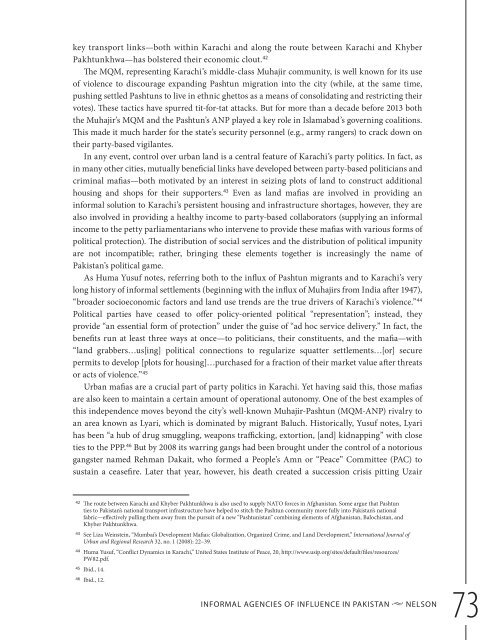pakistan’s
SR55_Mapping_Pakistan_February2016
SR55_Mapping_Pakistan_February2016
Create successful ePaper yourself
Turn your PDF publications into a flip-book with our unique Google optimized e-Paper software.
key transport links—both within Karachi and along the route between Karachi and Khyber<br />
Pakhtunkhwa—has bolstered their economic clout. 42<br />
The MQM, representing Karachi’s middle-class Muhajir community, is well known for its use<br />
of violence to discourage expanding Pashtun migration into the city (while, at the same time,<br />
pushing settled Pashtuns to live in ethnic ghettos as a means of consolidating and restricting their<br />
votes). These tactics have spurred tit-for-tat attacks. But for more than a decade before 2013 both<br />
the Muhajir’s MQM and the Pashtun’s ANP played a key role in Islamabad’s governing coalitions.<br />
This made it much harder for the state’s security personnel (e.g., army rangers) to crack down on<br />
their party-based vigilantes.<br />
In any event, control over urban land is a central feature of Karachi’s party politics. In fact, as<br />
in many other cities, mutually beneficial links have developed between party-based politicians and<br />
criminal mafias—both motivated by an interest in seizing plots of land to construct additional<br />
housing and shops for their supporters. 43 Even as land mafias are involved in providing an<br />
informal solution to Karachi’s persistent housing and infrastructure shortages, however, they are<br />
also involved in providing a healthy income to party-based collaborators (supplying an informal<br />
income to the petty parliamentarians who intervene to provide these mafias with various forms of<br />
political protection). The distribution of social services and the distribution of political impunity<br />
are not incompatible; rather, bringing these elements together is increasingly the name of<br />
Pakistan’s political game.<br />
As Huma Yusuf notes, referring both to the influx of Pashtun migrants and to Karachi’s very<br />
long history of informal settlements (beginning with the influx of Muhajirs from India ater 1947),<br />
“broader socioeconomic factors and land use trends are the true drivers of Karachi’s violence.” 44<br />
Political parties have ceased to offer policy-oriented political “representation”; instead, they<br />
provide “an essential form of protection” under the guise of “ad hoc service delivery.” In fact, the<br />
benefits run at least three ways at once—to politicians, their constituents, and the mafia—with<br />
“land grabbers…us[ing] political connections to regularize squatter settlements…[or] secure<br />
permits to develop [plots for housing]…purchased for a fraction of their market value ater threats<br />
or acts of violence.” 45<br />
Urban mafias are a crucial part of party politics in Karachi. Yet having said this, those mafias<br />
are also keen to maintain a certain amount of operational autonomy. One of the best examples of<br />
this independence moves beyond the city’s well-known Muhajir-Pashtun (MQM-ANP) rivalry to<br />
an area known as Lyari, which is dominated by migrant Baluch. Historically, Yusuf notes, Lyari<br />
has been “a hub of drug smuggling, weapons trafficking, extortion, [and] kidnapping” with close<br />
ties to the PPP. 46 But by 2008 its warring gangs had been brought under the control of a notorious<br />
gangster named Rehman Dakait, who formed a People’s Amn or “Peace” Committee (PAC) to<br />
sustain a ceasefire. Later that year, however, his death created a succession crisis pitting Uzair<br />
42 The route between Karachi and Khyber Pakhtunkhwa is also used to supply NATO forces in Afghanistan. Some argue that Pashtun<br />
ties to Pakistan’s national transport infrastructure have helped to stitch the Pashtun community more fully into Pakistan’s national<br />
fabric—effectively pulling them away from the pursuit of a new “Pashtunistan” combining elements of Afghanistan, Balochistan, and<br />
Khyber Pakhtunkhwa.<br />
43 See Liza Weinstein, “Mumbai’s Development Mafias: Globalization, Organized Crime, and Land Development,” International Journal of<br />
Urban and Regional Research 32, no. 1 (2008): 22–39.<br />
44 Huma Yusuf, “Conflict Dynamics in Karachi,” United States Institute of Peace, 20, http://www.usip.org/sites/default/files/resources/<br />
PW82.pdf.<br />
45 Ibid., 14.<br />
46 Ibid., 12.<br />
INFORMAL AGENCIES OF INFLUENCE IN PAKISTAN u NELSON<br />
73



